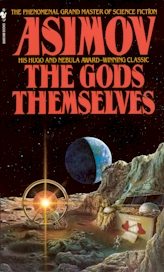
Hugo Award and Nebula Award Winner
Current Bantam Spectra paperback
cover art by Don Dixon
293 pages (left)
Fawcett 1st edition paperback
1973 - 288 pages (right)

Denver Science Fiction & Fantasy Book Club |
 |
The Gods Themselves (1972) Hugo Award and Nebula Award Winner Current Bantam Spectra paperback cover art by Don Dixon 293 pages (left) Fawcett 1st edition paperback 1973 - 288 pages (right) |
 |
| Dan | 9 | Amy | 7 |
 |
10 Wow! Don't miss it 8-9 Highly recommended 7 Recommended 5-6 Mild recommendation 3-4 Take your chances 1-2 Below average; skip it 0 Get out the flamethrower! U Unfinishable or unreadable - Skipped or no rating given |
| Cheri | 8 | Barb | - | ||
| Aaron | 9 | Cynthia | - | ||
| Jackie | - | Ron | 6 | ||
| Christine | 8 | Mitch | - | ||
| Amelia | 8 |